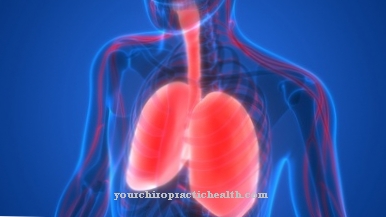The convection plays a major role in the body's thermoregulation. It characterizes the heat transport in the body and the heat release to the outside world. Disturbances in the exchange of heat can be caused by illnesses and have a severe impact on the body's heat balance.
What is convection

In the thermoregulation of organisms, convection represents a certain form of heat transport during heat exchange. The heat exchange takes place here via a material medium. In this way, the heat can be transported via a liquid such as water and then transferred to a gaseous medium, the air.
In the case of body temperature regulation, the liquid medium is the blood in the bloodstream and the gaseous medium is the outside air. As part of thermoregulation, the body tries to maintain its physiological body temperature whenever possible. In humans it is about 37 degrees.
Heat is generated primarily through metabolic processes and secondarily through friction during muscle work. The mechanical energy of muscle work is originally also obtained from metabolic activities.
With convection, the heat energy from the heat source is transported to all parts of the body by the flowing blood in the blood vessels. There is constant heat transport to balance the body temperature, which, however, has to be regulated by hormonal processes.
In addition, there is an exchange of heat between the body and the outside world, with the body giving off heat to the environment. This heat transport is restricted via the thermoregulation in the event of high heat loss due to low outside temperatures or promoted in the case of excessive heat production in the body.
Function & task
The heat exchange through convection should help to keep the body temperature constant. In addition to convection, there is also heat exchange via evaporation (evaporation) or radiation (radiation).
The body controls the heat exchange via regulation mechanisms in such a way that the body temperature is neither exceeded nor undershot. All physiological processes are temperature-dependent and only run optimally at body temperature. If the body temperature is too low, the metabolic processes are slowed down. Temperatures that are too high have a major impact on the structure of the biomolecules. The denaturation of the body's own proteins begins at temperatures above 40 degrees. The secondary, tertiary and quaternary structures of the proteins are destroyed, losing their biological effectiveness. Enzymes in particular are impaired in their functionality.
Furthermore, the fluidity, the diffusion behavior and the osmosis behavior of the cell membranes change. At higher temperatures, the binding affinity of hemoglobin for oxygen continues to decrease, so that the oxygen supply would no longer be adequately guaranteed.
In order to ensure a constant body temperature, the coordinated sequence of several processes is necessary. This concerns, among other things, the constant heat production, the heat insulation and the ability of the body to increase heat dissipation in the event of overproduction of heat.
When the body becomes overheated, the hypothalamus causes the sympathetic tone to decrease. There is peripheral vasodilation and increased perspiration. The formation of perspiration causes an increase in heat loss through evaporation and vasodilation increases the heat dissipation through convection.
Vasodilation is the expansion of blood vessels to increase their surface area. This makes the heat dissipation more effective. The convection is also necessary for the even heating of the body. The core of the body, consisting of the abdomen and skull, is heated more strongly by the metabolism than the acres and extremities. The differences are balanced out through forced convection through the bloodstream.
You can find your medication here
➔ Medicines for cold feet and handsIllnesses & ailments
The convection in thermoregulation is largely dependent on the functionality of the blood vessels. In the case of circulatory disorders, even heating of all body parts no longer works optimally. Parts of the body that cool down quickly and are not heated as much at the same time remain cooler than the neighboring regions. For example, cold hands or feet often occur in atherosclerosis. They cannot be brought to body temperature so quickly even through passive heating from the outside. There is always a rapid cooling.
Physical activity can improve blood circulation. In severe cases, however, there is a risk of an insufficient supply of oxygen and, in extreme cases, necrosis of the corresponding limbs. Diabetes patients in particular often suffer from circulatory disorders, which can result in the loss of certain limbs.
Reduced blood flow (ischemia) also affects the extent of vasodilation. The shear forces within the blood vessels are changed by ischemia. The shear forces mediate the expansion of the blood vessels. However, decreased blood flow lowers the shear forces, so that there is also less vasodilation. Older people in particular often suffer from a disturbed heat balance. The control mechanisms no longer work optimally. On the one hand, the general heat production is reduced and, on the other hand, the heat transport is restricted by convection processes, since there is often a reduced blood flow. The body cools down more particularly in the areas with less blood flow.
However, the regulatory mechanism can also collapse if the body overheats. Overheating can result, among other things, from increased heat production during heavy physical exertion during humid weather conditions. When the core temperature rises above 41 degrees, sweat production stops at the same time. The body will try to dissipate the heat by increasing the blood flow to the limbs and acra and thus lower the core temperature. As a result, a circulatory collapse can threaten. This condition is known as heat stroke. The body's heat regulation can also be disabled if the fever is severe.













.jpg)

.jpg)
.jpg)











.jpg)